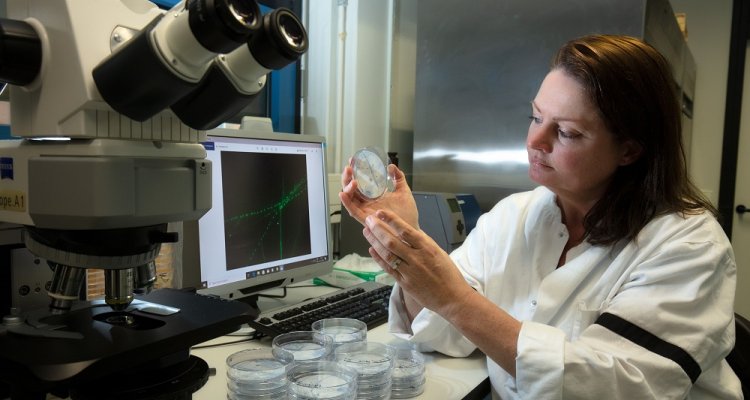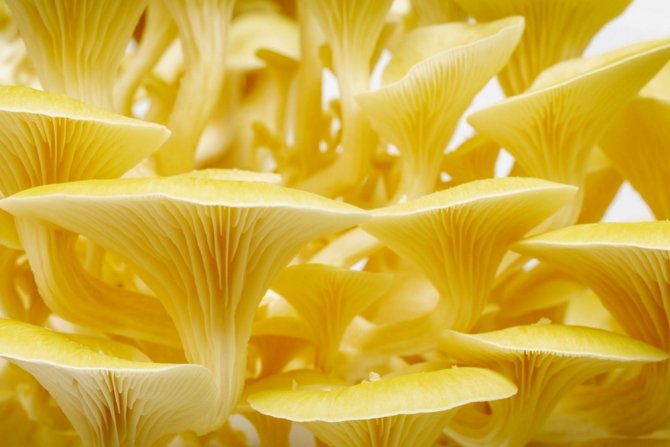
Interview
The mushroom as a protein source of the future
With the world’s population set to continue to grow significantly over the next few decades, there is a pressing need for new and, importantly, sustainable sources of protein. In their quest to find them, scientists are looking at edible mushrooms with particular interest. Researcher Karin Scholtmeijer is hunting through Wageningen’s vast mushroom collection for prime candidates for protein production. She also wants to find out how protein levels in mushrooms can be further improved.
Scholtmeijer has been fascinated by mushrooms ever since she studied microbiology at the University of Groningen. “They are unique organisms,” she explains. “A mushroom is neither a plant nor an animal, and unlike bacteria and viruses, you can see a mushroom with the naked eye. They also make excellent model organisms. In plant research you are often heavily dependent on the growing season, whereas you can grow entire fruiting bodies of some mushroom species in the space of just a week.”
Decomposers of woody waste
Compared with other alternative protein sources, mushrooms have one big advantage, Scholtmeijer says: “They break down woody waste and convert it into food. That is completely unique to these organisms. Also, you don’t need large areas of agricultural land to grow them; even a dark cave or an empty factory building will do.”

In addition, they produce protein – although not yet to the extent often claimed by product developers: “Our analyses show that protein levels cited in the literature can often be up to four times too high. It’s certainly not the case that mushrooms have high protein levels by definition.”
Sixty mushroom species selected
To get the most out of mushrooms as a supplementary source of protein for food, Scholtmeijer manages a research line funded by Wageningen University & Research. This project was selected by staff and students as one of the six research projects to receive funding for its potential contribution to the development of alternative protein sources.
To begin with, Scholtmeijer and her colleagues are looking for mushrooms with high protein levels: “We have a very extensive collection of mushrooms, which is growing all the time. From these, we selected 60 edible species. We are growing these on different substrates and in a range of growing conditions. Then we analyse which proteins each species contains and what properties they have. We are not only studying the mushrooms themselves but also the mycelium, the network of fungal threads that is normally thrown away.”
It may very well be that one mushroom produces a lot of protein on beet pulp while another does well on wood chips
Improving protein levels
Scholtmeijer also wants to find out more about exactly how the selected species accumulate protein. This knowledge is needed in order to improve protein levels in mushrooms. She explains: “This can be done using conventional breeding or molecular biological techniques, but also using random mutagenesis and by screening strains for higher protein production. Finally, we are also looking at the influence of growing conditions and substrate choice. It may very well be that one mushroom produces a lot of protein on beet pulp while another does well on wood chips.”
Fresh, fruity aromas
Although the research has only just started, Scholtmeijer is already seeing surprising developments in the lab: “As a researcher I have always worked mainly with two edible mushrooms: the common mushroom and the split gill, which is also used for medicinal purposes. When you put these on a culture plate, white fluffy fungal threads form. I am fascinated by the variety of structures, colours and aromas that I am already seeing in the lab. It really is great to see – and smell – such diversity. What particularly stands out for me are the many aromas, which are often pleasantly fresh and fruity. I can well imagine them being used in food products in the future.”
This is, after all, what the research is taking its first steps towards: healthy, tasty food products based on mushrooms and mycelium. “We want to help ensure that these products really are ‘high in protein’ in the future – so that the claim that is already often seen on packaging today can actually be lived up to.”